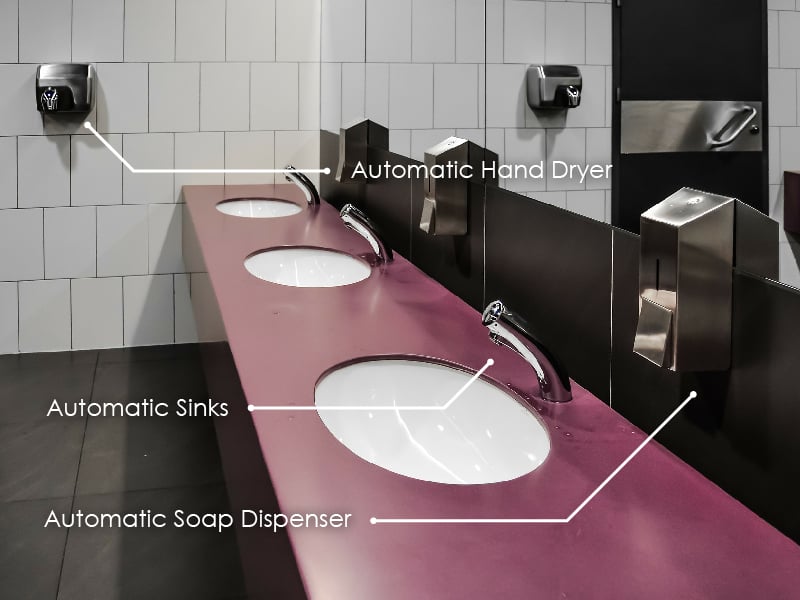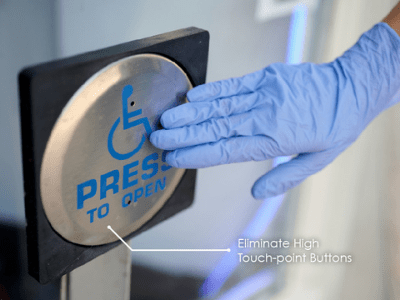
Proximity Sensing Can Eliminate the Need for Touch.
Have you realized just how many commonly touched surfaces we come into contact with on a day to day basis? I’m sure with the newfound state of the world, you’re beginning to realize it. There are so many places and things that we interact with daily that thousands of other people have also touched. This is how germs and bacteria are able to spread so quickly and easily. But what if there was a solution aside from keeping a bottle of hand sanitizer in your back pocket? With proximity sensing, there is!
What is Cap Touch?
Capacitive touch sensors have become a popular alternative to traditional interfaces such as membrane switches and keypads. They provide the same functionality as traditional interfaces, as they help to add functionality to your product. Rather than pushing a button where you’d feel some sort of tactile feedback, you would touch the button on a screen, similar to your phone, where there is no tactile feedback.
In simple terms, capacitive touch requires a sensor pad, a circuit board, and software that can drive the circuit. The software is the most important aspect of cap touch, as it provides the sensor the smarts it needs in order to determine when the capacitance has changed.
There are limitations to capacitive touch interfaces. Without a tactile ‘click’, developers rely on audible beeps or lighting to provide feedback. Water can also interfere with cap touch. There are clever ways to develop the software so that it helps to ensure that the capacitive circuit works properly, regardless of water exposure.
When creating your cap touch design, there are 3 potential types of cap touch sensors. They could be printed directly onto a graphic overlay, in-mold electronics that are integrated into the plastic housing, or etched directly onto a circuit board. Regardless, there cannot be air gaps in the cap touch design.
What is Proximity Sensing?
Proximity Sensing can be defined as, “a sensor able to detect the presence of nearby objects without any physical contact”. Basically, through the use of a proximity sensor, physical touch is not required to activate a switch or action. They can sense the proximity of a conductive object. You would simply hover your hand over the sensor in order to activate it; Similar to motion-activated paper towel dispensers you commonly see in a restaurant bathroom. However, motion-activated paper towel dispensers are just that; Motion activated. The primary difference between motion sensors and proximity sensors is that proximity sensors don’t require motion to activate or work properly.
How can they work together?
A proximity sensor is able to be incorporated into your capacitive touch design. Cap Touch sensors are a stack-up of conductive inks. By simply adjusting the sensitivity of the control board, you could make it so that hovering over the sensor would activate it. Ultimately, this would mean that you wouldn’t need physical touch, just to be in the general vicinity of the sensor in order to activate it. This would entirely eliminate the need for physical touch, thus helping to slow the spread of bacteria and other harmful germs.
Common Applications for Proximity Sensing
When comparing proximity sensors to motion sensors, it can be difficult to decide which may be the best option for your application. There are several scenarios where motion sensors may be the better option, especially when it comes to having multiple sensors on a singular device. There can only be 1 proximity sensor on a device, because if there were multiple, then the fields would interact poorly with each other.
However, proximity sensing also has several benefits over that of a motion sensor. One example would be that motion is not required in order to activate it. You just simply need to be within the appropriate proximity of the sensor. This could be extremely beneficial in several scenarios, especially within a hospital or surgical setting.
Light Switches
Light switches are one of the most common touchpoints people interact with on a day to day basis. Through the use of capacitive touch and proximity sensors, the actual touch of the light switch could be eliminated entirely. You could hover over the light switch in order to activate it to either turn it on or off. Just by being in close proximity to the sensor, the light switch will activate.
Doors/Entryways
Let’s consider a hospital setting, for instance. When you go to use doors within a hospital, there oftentimes are buttons that need to be pressed in order to activate the doors to open. This is especially true with the common Handicap Accessible button we see beside nearly every door in the facility. But have we considered how often those buttons are used? And even better, have we considered how many times they’re actually cleaned? I’d assume not very often.
But through proximity sensors in these buttons, the need for physical touch is entirely eliminated. You’d simply hover your hand over the switch, and the doors would open. This eliminates the thousands of germs and bacteria you’d interact with within the other scenario.
Industrial Controls
Proximity sensors can be easily incorporated into industrial control designs. An example would be on an industrial control panel found within a manufacturing setting. By adding a proximity sensor into the “Emergency Stop” buttons, it could help to mitigate the risks of injuries within the workplace. By simply hovering over the Emergency Stop button, you could shut off machinery quickly and efficiently.
Proximity can activate a set of controls when a person is near a piece of machinery. This will help save power or activate additional controls.
The proximity sensor can also be used for safety around machinery. When someone’s hand is within a moving component, proximity sensing can be used to disable the main power so that the operator is protected.
Instruments
Proximity sensors can also be incorporated into instrument interfaces, such as membrane switches, graphic overlays, etc. Consider how efficient proximity sensors could help you to be, especially in a scenario such as a hospital environment. When a doctor is in surgery, touch could be eliminated entirely on their user interface designs. This would eliminate the need for decontamination while making machinery operation a simple step.
Bathrooms
Bathrooms are the single most germ-infested areas that we interact with on a day-to-day basis. Whether it be the doors to enter/exit the bathroom, the toilet seat handles, the handles for the sink, or the paper towel dispenser we use, each and every one of these items is carrying harmful germs and bacteria. But what if you didn’t have to physically touch any of these surfaces?
Proximity sensors could be incorporated into each of these common touchpoints, eliminating the need for the physical touch. You’d hover your hand over the sink, or the paper towel dispenser, or the toilet seat handle, and they’d function just as they would with the physical touch. This could potentially help to stop the spread of thousands, if not millions, of germs per year.

Proximity sensors have the potential to be used in so many different applications. They could help to stop the spread of thousands, if not millions, of germs per year. With the newfound state of the world, people are germ cautious. Because of this, proximity sensors may become the new norm for many common touchpoints we interact with on a day to day basis. If you’re interested in learning more about Proximity Sensors and Capacitive Touch or would like to get your next project started, reach out! Our team of engineers is ready to help you every step of the way.
 Meet the Author: Jaclyn King
Meet the Author: Jaclyn King
Jaclyn is a Marketing Communications Specialist on the BTI Team. She serves as the Content Manager, where she primarily manages social media channels, SEO, Public Relations, and website development. To get to know more about Jaclyn, check her out on LinkedIn!
